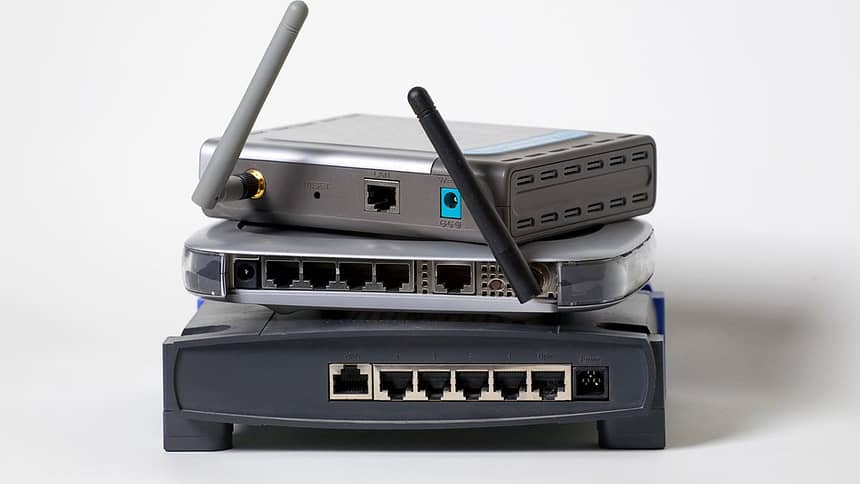For most home internet users, establishing fast internet speeds usually means upgrading to a faster plan or signing up for a new service. However, there may be a more straightforward way to achieve faster speeds, and even save more money in the long run. Understanding this one small technical detail about your router can change the quality of your internet connection.
Determining what kind of Wi-Fi band you have can provide more insights into how to optimize your internet connection. Most routers are equipped with either 2.4GHz or 5GHz (in some cases both), but if you can choose only between the two, CNET recommends the 5GHz since it boasts faster speeds and less interference from other devices.
Sandeep Harpalani, vice president of product management at Netgear, tells CNET that the average home in the US has over 20 connected devices running at any given time. “This includes static IoT devices, which may not be robust enough or even require more than 2.4GHz, and mobile devices such as phones, PCs and tablets used for streaming or gaming,” Harpalani said.
When choosing the right Wi-Fi band for their router, Harpalani recommends that home internet users assess their internet speed usage, the number of devices in the home and their online activities. Let’s dive into the details.
What is a Wi-Fi band?
Your Wi-Fi connection uses the power of radio waves to transmit data wirelessly from your router to other connected devices. Most Wi-Fi routers are equipped with frequency bands of either 2.4 gigahertz or 5GHz and, in some cases, both. According to Britannica, hertz is a measurement of the frequency of waves. For example, one hertz can translate to one wave per second, whereas one gigahertz can equal one billion waves per second.
Don’t let these technical terms or numbers confuse you. The key thing to know is that every router has a Wi-Fi band that can send a specific amount of data to other devices. These Wi-Fi bands can impact various factors, such as speeds, range and the likelihood of nearby devices interfering with your connection.
How to know which Wi-Fi band you have?
The simplest way to tell which Wi-Fi band you have is to access your Wi-Fi network panel through your mobile device or computer. Navigate through the Wi-Fi networks available. If you see multiple similar network names with either 2, 2G, 2GHz or 5, 5G, or 5GHz associated, this can signify the specific Wi-Fi band used. Sometimes, the network name without any of these terms can signify the 2.4GHz network.
As a Windows user, I determined that my Wi-Fi band is 5GHz by accessing my Wi-Fi network panel settings.
However, if checking the Wi-Fi network names on your mobile device is unclear, a more effective solution would be to check using your computer.
- MacOS users: Click on the Wi-Fi icon while holding down the option or alt key, then look for the channel category. Next to the channel category, you should see if your Wi-Fi band is 2.4 or 5GHz.
- Windows users: Open the network panel from your taskbar, then click on Wi-Fi. Next, click on properties and scroll down to network band details. Then, look for mentions of 2.4 or 5GHz.
2.4GHz vs. 5GHz: What is the difference?
Now that you know what type of Wi-Fi band you have, let’s explore each band’s capabilities. When comparing Wi-Fi technology equipped with 2.4GHz and 5GHz, consider range, speed and interference from nearby devices.
Network range
If your network displays a Wi-Fi band of 2.4GHz, your internet connection will cover a wider area, making it suitable for larger homes. Whereas with 5GHz, the range is likely to be limited and is less effective in penetrating through walls. CNET’s broadband expert, Joe Supan, visited the CNET labs in Louisville, Kentucky, where we test routers to test the ranges of each band. After conducting a series of signal strength tests, it was determined that the 2.4GHz band offered better range than the 5GHz band. Read more about how we test Wi-Fi routers here.
Still, a 5GHz band can provide adequate coverage for a smaller home, especially if the router is in a central location. According to CenturyLink, using devices near the router if you have a 5GHz Wi-Fi band is best. Alternatively, home internet users can invest in a Wi-Fi extender to reach more areas throughout the home. I put this to the test when troubleshooting my slow gigabit speeds at home.
Internet speeds
Despite a limited range, a 5GHz Wi-Fi band will boast faster speeds. This is an ideal option for activities that require speedier bandwidth. You can benefit the most from a 5GHz band if you stream in 4K, game online or conduct video conferencing. These fast speeds are due to the 5GHz technology’s ability to transmit higher data rates. A 2.4GHz Wi-Fi band won’t produce the same speeds, but it should be enough to support basic web browsing and checking emails.
Read our comprehensive internet speed guide to learn how much speed your household needs.
Device interference and Network Congestion
One disadvantage of using a 2.4GHz Wi-Fi band is that it’s more susceptible to interference from other devices on the network. Certain connected devices, including smart home devices, microwaves and Bluetooth speakers, can crowd your network. Too many devices can lead to network congestion when the traffic moving through your network is at its capacity, which can significantly reduce your speeds.
2.4GHz and 5GHz: pros and cons
What is a dual-band router?
You can invest in a dual-band router if you don’t want to choose between either. This router is best suited for various Wi-Fi 6 compatible devices, like the latest iPhone models, Apple TV, Google Pixel 6 and 7 and so on. A dual-band router is equipped with technology that can broadcast two separate frequency bands; in other words, it can support both Wi-Fi bands: 2.4GHz and 5GHz. Using a dual-band router can effectively enhance your internet connection by featuring faster speeds, broader coverage throughout your home and reducing interference from other nearby devices.
The bottom line
“Devices in a home always have a mix of varying requirements when it comes to Wi-Fi. One size does not fit all,” Harpalani said.
“The good news is that if you pick a router or mesh system that supports your very latest, highest performing device, everything else in your home will be covered.”
Determining which Wi-Fi band is better will depend on the size of your home, your household’s online activities and the number of connected devices to your network. But CNET recommends going with 5GHz as it features faster speeds which can support many activities such as streaming, gaming and videoconferencing. While a 2.4GHz Wi-Fi band can cover more area, being perfect for larger homes, the downside is that you’ll likely experience slower speeds and be prone to interference from other electronic devices. A 5GHz Wi-Fi band provides less range, but you can always invest in a Wi-Fi extender to reach the dead spots in your home. On that note, you can also invest in a dual-band router to use both 2.4GHz and 5GHz technology, enhancing your overall internet connection.
2.4GHz vs. 5GHz Wi-Fi band FAQs
A Wi-Fi band is the range of frequencies broadcasted from your router to nearby devices. Most routers are equipped with Wi-Fi bands of 2.4GHz and 5GHz.
Is a 5GHz Wi-Fi band faster than 2.4GHz?
A Wi-Fi band of 5GHz will be the best option for most households looking for a reliable and fast internet connection. While the 2.4GHz band can accommodate larger homes since it offers broader coverage, it’s not as fast. More importantly, a 2.4GHz band is susceptible to interference from electronic devices nearby, resulting in network congestion. Home internet users will likely experience reduced speeds during times of network congestion
How can I optimize my connection using a Wi-Fi band?
To maximize your Wi-Fi band, consider the following factors: range, speed and interference from nearby devices. Each Wi-Fi band has a unique set of benefits and drawbacks. If you’re looking for top speeds, a 5GHz band will be a solid choice. However, larger homes can benefit the most from a 2.4GHz band since it provides more coverage throughout the house.
How do I know which Wi-Fi band I have?
A simple way to know which Wi-Fi band you have is to access your Wi-Fi network panel settings through your mobile device or computer. Though checking through your computer might be a more effective solution. This will look slightly different depending on what type of device you use.
Below are instructions for Windows and MacOS users:
MacOS users: Click on the Wi-Fi icon while holding down the option or alt key, then look for the channel category. Next to the channel category, you should see if your Wi-Fi band is 2.4 or 5GHz.
Windows users: Open the network panel from your taskbar, then click on Wi-Fi. Next, click on properties and scroll down to network band details. Then, look for mentions of 2.4 or 5GHz.
Should I set my Wi-Fi to 2.4GHz or 5GHz?
Choosing which Wi-Fi band is right for you will depend on the size of your home and your broadband needs. If your household frequently streams and plays games, then you should set your Wi-Fi to use the 5GHz band. On the other hand, setting your Wi-Fi to use a 2.4GHz band will come in handy if you own a larger home. Depending on the type of router you have, you may be able to broadcast both bands simultaneously, which is the case for dual-band routers.
Do devices automatically switch between 2.4 and 5GHz?
Some routers are equipped to automatically switch between 2.4GHz and 5GHz bands.
While reviewing some of the best Wi-Fi routers on the market, CNET broadband expert Joe Supan, writes that “some routers will automatically steer your connection between multiple bands available, but you can usually turn that off as well, making each band it’s own, separate Wi-Fi network.”






